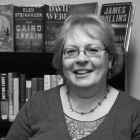
Jackie Hemond
Love is all around me since my daughter got engaged on New Year’s Eve. We have visited wedding venues, tasted food, kissed and sighed over happily ever after. Additionally, stores are festooned with hearts and cupids in anticipation of Valentine’s Day. And who can avoid the Hallmark Channel’s endless, streaming love stories? Yes, love abounds everywhere, including libraries.
Many public libraries serve as venues for wedding celebrations. In Connecticut, the Blackstone Memorial in Branford serves as one. Housing some of the greatest love stories of all times, libraries are the perfect wedding venue for bibliophiles. Storybook romances celebrate love in front of actual storybooks!
However, every day in the library is filled with love stories, passion and heartbreak, all on the romance book shelves. Although sneered at by literary critics, and hardly ever reviewed in The New York Times Book Review, modern romance novels are popular. Debbie Macomber, Nora Roberts, Nicholas Sparks and Danielle Steel are names which pop up again and again in the romance genre. Fifty Shades of Gray with its extra steamy eroticism and the Harlequin publishing company’s muscle-bound male covers and clever marketing techniques increased the passion for this genre. In the 1970s, Harlequin stocked their books where the women would see them – in the grocery or drug stores, and also packed them in laundry soap and personal care items. Harlequin’s ploys worked and the demand for romance novels surged. Still, the all-time favorite romantic novels remain the classics written by Jane Austen, the Bronte sisters, Margaret Mitchell and Daphne du Maurier.
Although there is evidence that there were romantic novels in ancient Greece, most trace the history of the romance novel back to 1740 when Samuel Richardson published his novel Pamela about a servant girl who successfully wards off her employer’s advances until he marries her. Since then, the “tale as old as time” is continually repeated. There are few rules regarding the structure of romance novels. They have to include a love interest, and are generally told from the woman’s point of view. Conflicts, misdirections and subplots add interest. Good and evil intricately wind through the plot, although ultimately, most novels end “happily ever after”. That’s basically it.
If I haven’t piqued your interest in romance novels, come to the library to find love anyway. February is also “Love Your Library” month. In these countdown days before we are back up at 50 North Main Street, the staff and I can sure use your love. Until then, please love the place we’re in!